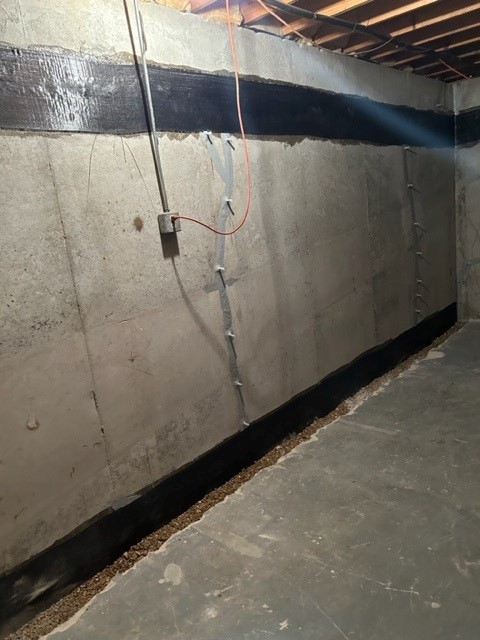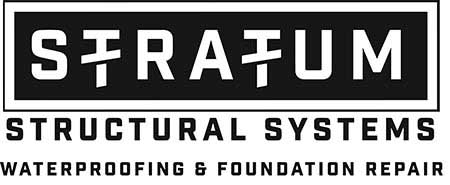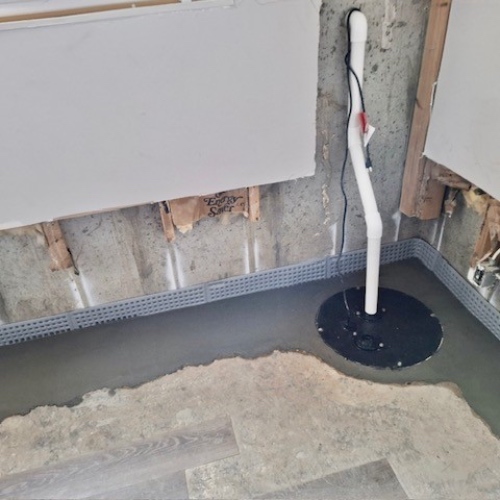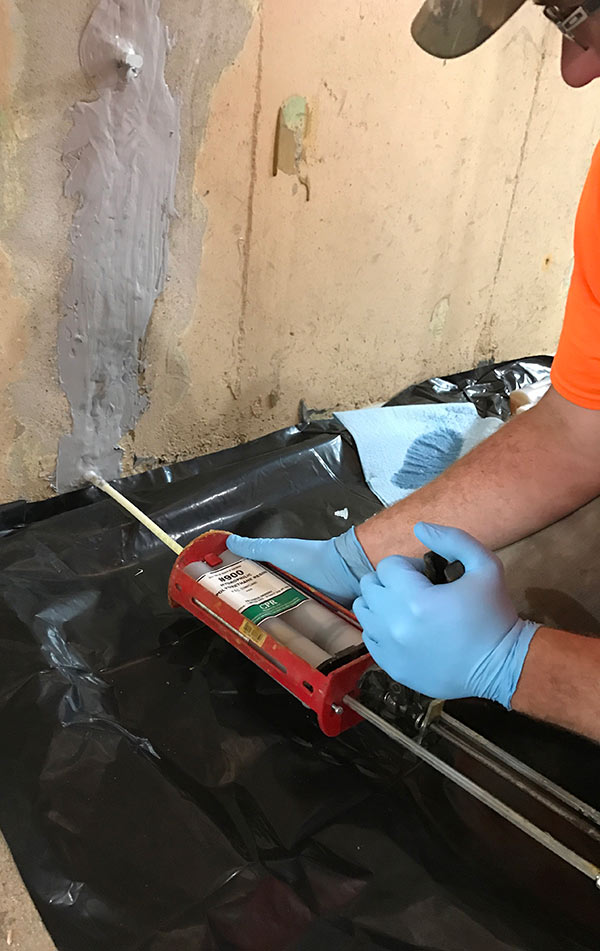Carbon Fiber Straps for Bowing Walls: A Permanent Solution?

The fear of water damage and structural instability is a constant concern for homeowners. Inspect your home regularly for bowing walls. These are indicators of foundational problems.The good news is that there are modern and reliable methods available to stabilize bowing walls. One such innovative solution is the use of carbon fiber straps. These bowing wall repair methods have gained popularity for their strength, durability, and minimal disruption during installation. Whether you’re looking to safeguard your basement from further deterioration or simply want to ensure your home remains safe and secure, carbon fiber straps could be the answer. Let’s take a closer look!
What is a Bowing Wall?
When a foundation wall moves inward, the cause is usually due to excessive saturation of the soil on the exterior of the wall. As it moves laterally, it normally presents this in one of two different ways.
- The foundation wall may bow inward at the mid height or middle of the wall and you may notice a long horizontal foundation crack.
- Similarly the foundation may rotate inward when it receives pressure near the top of the wall. As the wall “rotates” or tilts in, you may notice diagonal foundation cracks on each end.
What Are Carbon Fiber Straps for Bowing Walls?
Carbon fiber straps offer a modern, highly effective solution for stabilizing bowing basement walls. They’re made from incredibly strong and lightweight carbon fibers.
These straps are up to ten times stronger than steel in tensile strength. As you can imagine, they provide superb reinforcement without adding bulk or stress to the structure. That makes carbon filters an ideal solution for bowing walls.
It is crucial to note that the carbon fiber strap should only be used when the wall is actually bowing, where you may notice a horizontal crack. If you see diagonal cracks on each end, STOP! This may require an alternative repair. Expert advice is crucial in understanding the nuances of these details!
How to Install Carbon Fiber Straps to Fix Bowing Walls
Using carbon fiber straps for bowing wall repair isn’t a DIY solution. It requires structural knowledge and precision.
Installation involves attaching these straps vertically along the entire wall, from base to sill plate, ensuring comprehensive support unlike steel I-beams. The process includes preparing the wall surface, applying epoxy adhesive, and securing the strap to both the wall and a sill plate bracket.
Once installed, these straps prevent further wall movement, effectively stabilizing it against external pressures like hydrostatic pressure. Their discreet design allows them to be easily concealed with paint or drywall, preserving the basement’s aesthetic appeal.
What are the Benefits of Using Carbon Fiber Strips for Bowing Walls
A bowing wall can easily change from a gradual issue to a disaster. Don’t cost yourself more money and stress in the long run. Fixing bowing walls as soon as possible is crucial to prevent further structural damage and potential water intrusion. Carbon fiber straps can be an excellent choice for your home. This option is a combination of strength, aesthetics, and convenience that addresses these concerns effectively. Here are some reasons why you should talk to a St. Louis contractor about carbon fiber strips for repairing bowing walls.
Strength and Durability
Carbon fiber straps are renowned for being stronger than steel, which was long the standard bearer for fixing bowing walls. Their exceptional tensile strength ensures that carbon fiber straps can withstand significant external pressures without compromising their integrity.
Additionally, carbon fiber is non-corrosive. That means these materials won’t degrade over time due to moisture or other environmental factors. As a result, carbon fiber straps may provide a long-lasting solution for stabilizing bowing walls.
Aesthetic Appeal
No one likes an unsightly support system on their property. One of the standout benefits of carbon fiber straps is their discreet nature. Although steel support or anchoring systems have their place in the foundation repair world, so do carbon fiber straps.
Unlike steel beams or steel anchors, straps can be easily concealed with a coat of paint or covered with drywall. This makes carbon fiber straps ideal for finished basements where maintaining a clean look is important.
By blending seamlessly into the background, carbon fiber straps allow you to enjoy a structurally sound basement without compromising its aesthetic appeal.
Installation Advantages
The installation of carbon fiber straps offers significant advantages over traditional methods. Steel anchors often require exterior excavation and can be highly disruptive.
Comparatively, carbon fiber straps can be installed entirely from the inside. This means minimal disruption to your daily life. Plus, there is no need to excavate around your home. Therefore, installing carbon fiber straps saves time and reduces the overall cost of the repair.
Additionally, the process is relatively quick. Therefore, this method allows you to get back to enjoying your basement sooner!
Considerations About Carbon Fiber Straps for Bowing Wall Repairs
When considering carbon fiber straps for bowing walls, it’s important to understand their effectiveness and limitations. These straps are most effective for walls that are bowing less than two inches.
Carbon fiber straps provide excellent support and stabilization for minor to moderate damage. They ensure that the wall does not bow further, offering a reliable solution for homeowners dealing with early signs of structural issues.
However, for walls bowing more than two inches, alternative solutions are typically required. In such cases, methods like steel wall anchors are often necessary along with a full excavation and the removal of the source of the problem…the expanding clay soil.
Steel I-beams provide strong, immediate stabilization, making them suitable for bowing when the wall has shifted less than 2 inches. Meanwhile, wall anchors can gradually pull the wall back into place over time. Helical tiebacks are another option for extreme bowing, offering immediate correction and stabilization.
The installation process for carbon fiber straps involves careful preparation to ensure a strong and lasting bond. First, the wall surface is thoroughly cleaned and ground to remove any paint, coatings, or debris.
This step is crucial for creating a solid foundation for the carbon fiber straps. Any cracks in the wall are then filled with a high-strength epoxy to restore structural integrity before applying the straps.
Once the wall is prepared, the locations for the top and bottom anchors are marked and drilled to secure the straps firmly. A high-strength epoxy adhesive is applied to the prepared wall surface, serving as the bonding agent for the carbon fiber straps.
The straps are then installed onto the epoxy-coated surface, ensuring they are straight and securely attached from top to bottom. Finally, the straps are anchored at both the top and bottom to maximize stability and prevent further wall movement.
Get Bowing Walls Repaired in St. Louis with Carbon Fiber Straps
If you’re unsure whether carbon fiber straps are the right solution for your bowing walls, don’t hesitate to reach out to our team at Stratum Structural Systems. We understand that every home is unique, and what works for one may not work for another. Our experienced professionals are here to provide you with personalized advice and guidance, ensuring that you make an informed decision that best suits your needs. We’re committed to helping you find the most effective and lasting solution for your home, so feel free to contact us for a consultation.




